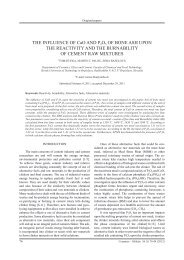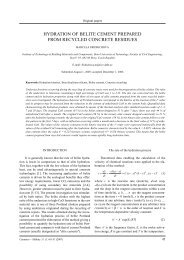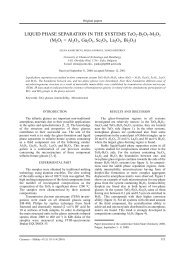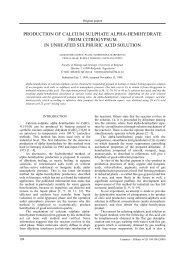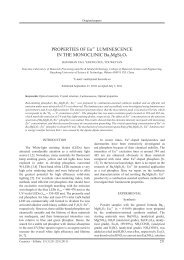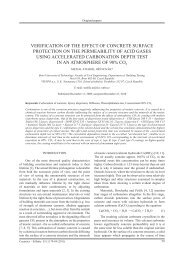TRIBOLOGICAL PROPERTIES OF CARBON ... - Ceramics-Silikaty
TRIBOLOGICAL PROPERTIES OF CARBON ... - Ceramics-Silikaty
TRIBOLOGICAL PROPERTIES OF CARBON ... - Ceramics-Silikaty
You also want an ePaper? Increase the reach of your titles
YUMPU automatically turns print PDFs into web optimized ePapers that Google loves.
carbons at low pressure are usually used. The process<br />
temperature is about 1200-1300°C for amorphous low<br />
temperature pyrolytic carbon (LTI, low temperature<br />
isotropic), up to 2200°C for partially crystalline<br />
pyrolytic carbon, and over 2200 C for pyrolytic graphite<br />
(recomendation of IUPAC,1995).<br />
Tribological examinations determine the friction<br />
coefficient for a combination of two materials classified<br />
as the substrate (e.g., in the form of disc) and body with<br />
specific properties and dimensions ("pin, corpuscle,<br />
ball, roller"), in a given environment. The action is<br />
usually realized by the movement of a ball or a roller<br />
of one material on the plane plate of another studied<br />
material. In the pin-on-disc analyses (ball on a plane<br />
plate) the corpuscle in the form of a roller or a nonrotating<br />
ball is placed on a surface of the specimens<br />
with the shape of a flat disc. The "pin" is loaded in<br />
advance by a defined force at a defined distance from<br />
the centre of the sample. At friction, the tangential force<br />
is caused by shear strength due to the asperities and<br />
their microhardness, which appears at the contact areas<br />
of two bodies. The axial tension loaded on the corpuscle<br />
arise the plastic deformation of both surfaces. In<br />
both cases of friction (adhesive and abrasive) the elimination<br />
of hills and transfer of material will depend on<br />
the ratio of tangential and axial stress tensions. In the<br />
case of dry friction, the test results usually depend on<br />
the following parameters: loading power, size of the<br />
contiguous surface, speed, temperature of the couple,<br />
environmental atmosphere, and, last but not least, the<br />
mechanical and physical properties of the materials of<br />
the sample and the corpuscle [7], mainly on the state<br />
and quality of their surfaces.<br />
The values of the friction coefficient and the size of<br />
the abrasion volume are clearly connected with the<br />
roughness of the contiguous surface. Accordingly, it is<br />
necessary to observe the individual surface roughness<br />
and surface state characteristics of the samples, from the<br />
point of view of appearance and frequency of failures,<br />
including breaches. It has been demonstrated [8] that<br />
the value of the friction coefficient, and its course, i.e.,<br />
the change during the examination or in running, and<br />
the wear and abrasion modes of the cutting marks depend<br />
on surface roughness. When the surface roughness<br />
is high, then intensive corpuscle jumping or "skipping"<br />
appears and, as a result, there is an extensive scatter of<br />
the measured friction coefficient values. The salient<br />
unevenness is gradually plastically deformed, and in<br />
this way the scattering of the measured values should<br />
decrease.<br />
Unfortunately, there is very little available information<br />
on the tribological properties of pyrolytic carbon.<br />
Around 1995, LTI pyrolytic carbon was intensively<br />
studied as a material for leaflets of heart valves from the<br />
point of view of wear [9,10]. The tribological properties<br />
of some other types of carbon compounds, mainly in the<br />
Tolde Z., Starý V., Kubart T.<br />
form of thin films, were also studied. Most of the available<br />
information is about carbon in the form of graphite<br />
for applications in electroindustry. In [11], the pin-ondisc<br />
measurements coefficient of friction was 0.02-0.1<br />
for a graphite pin/polycrystalline electrographite couple,<br />
at load 4N and sliding speed 0.03-0.05 m/s. It is<br />
supposed that abrasive wear creates the dangling bonds,<br />
located on the edge sites that lead to bad friction properties.<br />
Water vapour and oxygen passivate these bonds.<br />
Argon or helium decreases the friction coefficient much<br />
more, because their atoms insert themselves between<br />
the hexagonal planes of the graphite crystallites and<br />
separate them by intercalation. The cleavage strain<br />
exceeds the bonding strength between the layers, and<br />
the material can exhibit good friction properties.<br />
According to [12], the high orientation of surface crystallites<br />
obtained in the presence of water vapour during<br />
sliding leads to a pronounced decrease in the friction<br />
coefficient, and also in the wear rate.<br />
The tribological properties of pyrolytic carbon<br />
were also studied in our laboratory [13]. In this work,<br />
the friction coefficient and wear of polished C–C composite<br />
and of PyC on both unpolished and polished C–C<br />
composite were measured using a rotating cylinder<br />
on plate (HEF tribometer, France). The coefficient of<br />
friction depends strongly on the load between 40 and<br />
250 N. For polished samples with medium starting<br />
roughness a plateau was observed at approximately<br />
40-100 N. This non-monotonic growth of the friction<br />
coefficient was assumed to be due to optimal conditions<br />
of graphite debris spreading on the surface of the<br />
sample. The highest friction coefficient appeared for<br />
the sample with the lowest roughness. In the case of<br />
polished C–C composite, no stable state (plateau)<br />
appeared.<br />
Hardness is one of the basic parameters characterizing<br />
the mechanical properties of a material and also<br />
its friction and wear properties. It is known, that the<br />
volume of the worn down material (debris) is proportional<br />
not only to the load and the length of shear path,<br />
but also it should be inversely proportional to the hardness<br />
of the worn down material [14,15]. The influence<br />
of roughness on friction and wear for a diamond<br />
film/sapphire couple was studied in [16]. The friction<br />
and wear properties of thin films of polycrystalline<br />
diamond depend on both the counterface material and<br />
the properties of the diamond layer. The roughness of<br />
the diamond is critical, because it controls the amount<br />
of abrasive damage to the counterface. Also the tribological<br />
properties of other carbon compounds mainly<br />
DLC (diamond like carbon) were studied [6].<br />
The purpose of our work was to define the tribological<br />
properties of C–C composites and their change<br />
due to the layer of pyrolitic carbon and, moreover, to<br />
find the influnce of mechanical grinding of surface on<br />
friction and wear.<br />
38 <strong>Ceramics</strong> − Silikáty 52 (1) 37-44 (2008)



